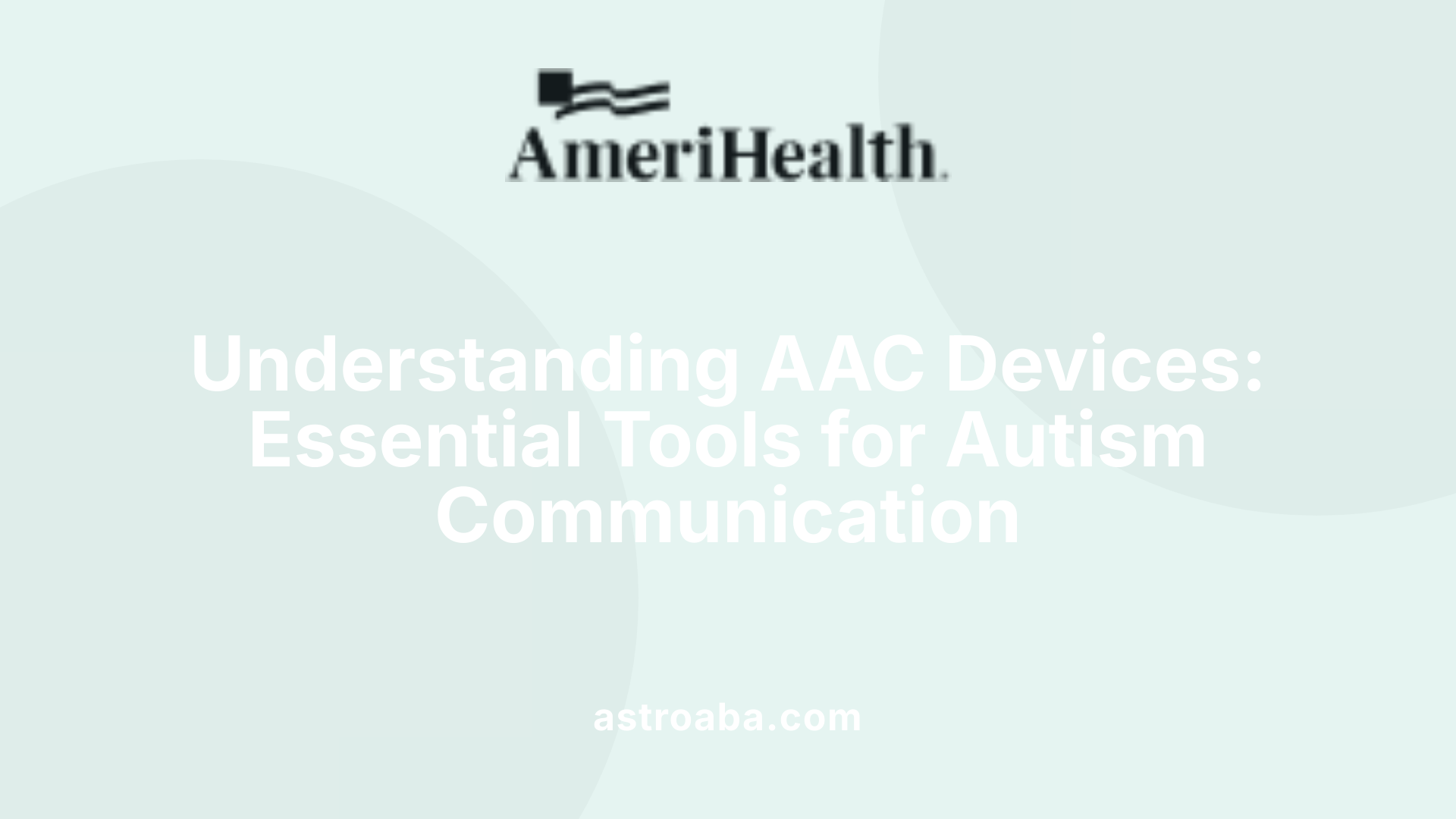What is an AAC Device for Autism?
Unlocking Communication: The Power of AAC Devices for Autism

Understanding AAC and Its Role in Autism Support
Augmentative and Alternative Communication (AAC) encompasses a broad range of tools and strategies designed to support or replace speech for individuals who have difficulty communicating verbally. With over 2 million users, AAC has become a vital part of intervention for many people with autism, helping them express their needs, share their thoughts, and build meaningful relationships. This article explores what AAC devices are, the various types available, benefits, and how to effectively select and support their use for autistic individuals.
What is an AAC device and its importance in autism support

What is an AAC device?
An AAC device is a communication tool designed to help individuals with speech or language difficulties express themselves more effectively. It encompasses a variety of options ranging from simple gestures and facial expressions to advanced electronic devices like speech-generating tools. These devices can be used when someone cannot speak, has limited speech, or needs additional support to communicate.
AAC devices fall into two main categories: augmentative, which enhances existing speech, and alternative, which replaces speech when it is not feasible. They serve as vital aids, especially for those with autism, helping them share thoughts, needs, and feelings.
Components of AAC systems
AAC systems are composed of different tools and strategies tailored to individual needs. Common components include:
| Type | Description | Example |
|---|---|---|
| Unaided | No external tools; uses the body’s own signals | Facial expressions, gestures, sign language |
| Aided | Requires external tools or devices | Picture communication boards, electronic speech devices |
| Technology-Based | Electronic devices with customizable features | Tablets with communication apps like Proloquo2Go, speech-generating devices |
Many AAC systems are multimodal, allowing users to combine gestures, symbols, text, and speech to communicate effectively.
Who can benefit from AAC?
AAC supports anybody with communication challenges, especially individuals with autism spectrum disorder (ASD). Children who do not develop speech normally, those with limited verbal skills, or individuals with conditions like apraxia or expressive language delays can all benefit.
Early intervention with AAC is crucial. Starting as soon as children show difficulties in speaking enables faster development of language skills and increases their participation in social and educational settings.
Many users of AAC experience improved confidence, independence, and social engagement. These devices offer flexible options, customized to suit different ages, abilities, and environments, ensuring everyone has a voice and the means to connect.
Categories and examples of AAC devices

What are the different types of AAC devices and examples?
Augmentative and Alternative Communication (AAC) devices are designed to support or replace speech for individuals who have difficulty communicating verbally. These devices are generally categorized into three types based on the level of technology involved: no-tech, low-tech, and high-tech.
No-tech tools involve simple, non-electronic methods such as gestures, facial expressions, or writing. These are often the first forms of communication used and are essential foundational skills.
Low-tech devices include tools like picture exchange systems (PECS), communication books, and communication boards. These aids utilize images, symbols, or written words that individuals can point to in order to express themselves. They are portable, easy to use, and cost-effective.
High-tech electronic devices are more advanced and often feature digital screens, customizable symbols, text-to-speech functionalities, and alternative access options like eye gaze or switches. Examples of high-tech AAC technology include tablet-based communication apps such as Proloquo2Go and dedicated speech-generating devices like the NovaChat and Tobii Dynavox.
| Type | Examples | Additional Details |
|---|---|---|
| No-tech tools | Gestures, facial expressions, writing | Basic methods, no equipment required |
| Low-tech devices | Communication books, picture exchange systems (PECS), picture boards | Portable, simple, often used in early stages or as backup |
| High-tech devices | Tablets with communication apps (Proloquo2Go), dedicated SGDs like NovaChat, Tobii Dynavox | Can be tailored with customize vocabulary, eye gaze, voice output |
Choosing the right AAC device involves considering the individual's motor skills, cognitive abilities, and communication needs. Whether simple gestures or advanced electronic devices, each serves to enhance communication, social interaction, and independence for users with autism and other communication impairments.
Supporting communication through AAC in autism

How do AAC devices support communication in individuals with autism?
AAC devices serve as vital tools for individuals with autism who have difficulty speaking or expressing themselves verbally. They provide alternative ways to communicate, such as selecting pictures, symbols, or words that produce auditory or visual output. This enables users to share needs, thoughts, and emotions effectively.
These devices often complement other forms of communication like gestures and facial expressions, forming a multimodal approach that enhances understanding and interaction. By supporting both receptive and expressive language, AAC helps users participate more actively in conversations and social settings.
A significant strength of AAC is its adaptability. Users or caregivers can customize the interface by adding or editing icons, phrases, and scripts tailored to individual preferences and situations. For example, building social stories or routine sequences helps children navigate new experiences confidently and self-advocate.
Incorporating multimedia features such as videos, image-based stories, or sound recordings can also reinforce learning and skill development. These elements help teach life skills, promote independence, and boost self-esteem.
Overall, AAC devices facilitate increased social interactions, support speech growth, and empower individuals with autism to communicate more freely and effectively, enriching their everyday lives and relationships.
Benefits and positive impacts of AAC devices for individuals with autism

What are the benefits of using AAC devices for individuals with autism?
AAC devices significantly enhance the lives of autistic individuals by improving their communication capabilities. These tools help reduce frustration and challenging behaviors often stemming from an inability to express needs or feelings effectively. By offering personalized options such as symbol-based systems, text-to-speech outputs, or visual cues, AAC devices can accommodate various motor and sensory needs.
These devices support both speech and non-verbal communication, giving individuals a way to share their thoughts, emotions, and requirements. Early and consistent use of AAC can stimulate language development, helping children and adults learn new words, form sentences, and engage more actively in social interactions. This promotes greater independence, allowing individuals to participate more fully in educational, social, and community activities.
Furthermore, AAC fosters social inclusion by enabling clearer communication with family, friends, and caregivers. It helps build relationships and enhances emotional well-being. Users often experience increased self-confidence and a sense of autonomy as they find more ways to express themselves.
Overall, the use of AAC devices not only improves effective communication but also reduces potential sources of frustration, promotes meaningful personal interactions, and supports overall quality of life. Investing in these tools can open doors for greater social engagement, personal growth, and a stronger feeling of inclusion within society.
Guidelines for selecting and supporting AAC devices
How can I choose and support an AAC device for an autistic individual?
Selecting the right augmentative and alternative communication (AAC) device involves a comprehensive assessment of the individual’s unique communication needs, abilities, and preferences. It is important to evaluate their motor skills, sensory sensitivities, and environmental context to determine which type of device will be most effective.
Collaboration with professionals such as speech-language therapists, occupational therapists, and educators is essential. These experts can conduct formal assessments, recommend suitable systems, and help tailor the device to the individual's requirements. Involving the autistic individual and their family in this process ensures that the choice is personalized and that the device aligns with the person’s motivation and daily routines.
Trying different options through trial periods allows caregivers and professionals to identify the most effective tools. This may include testing high-tech devices like speech-generating tablets or low-tech options such as picture boards or communication books. It is also important to verify insurance coverage, explore self-payment options like affordable apps (e.g., Proloquo2Go), or seek out services through school-based programs with an IEP.
Once a device is chosen, ongoing support is vital. Providing training for both the individual and their communication partners helps maximize the device’s benefits. Customizing the device—adding personalized messages, social stories, or specific vocabulary—can improve its relevance and usability.
Supporting AAC use also involves consistent modeling of device usage, creating ample opportunities for the individual to communicate, and updating or modifying the device as their skills develop. Avoiding pseudoscientific methods and sticking to evidence-based practices ensures respectful and effective support.
In summary, successful AAC support for an autistic individual hinges on thoughtful assessment, collaboration, trial, customization, and ongoing training—always aimed at fostering effective, meaningful communication that enhances independence and social participation.
When to consider AAC devices for autism and funding options
When should I consider using an AAC device for an individual with autism?
Deciding to use an AAC device depends on observing specific communication challenges. If a person with autism shows limited vocal speech, struggles to understand spoken language, or gets frustrated when trying to express themselves, AAC can be a valuable tool.
Signs that indicate AAC might be helpful include persistent gaps between their communication skills and those of their peers, or behaviors like tantrums that stem from communication difficulties. Early intervention is highly recommended to support language development and reduce behavioral issues.
A comprehensive assessment is vital before choosing an AAC device. This assessment involves professionals such as Speech and Language Therapists, educators, the individual, and family members. It examines the person's motor skills, sensory processing, cognitive abilities, and current communication methods.
Using AAC early can improve both understanding and expression, fostering better social interactions, educational progress, and daily independence. Tailoring the device to the individual’s specific needs ensures the most effective support for their communication journey.
Empowering Communication for a Brighter Future
In summary, AAC devices are powerful tools that can significantly improve communication, independence, and social participation for individuals with autism. Understanding the different types of AAC, recognizing when to implement them, and providing ongoing support and training are essential steps toward maximizing their benefits. With personalized strategies and the collaboration of professionals, families, and individuals, AAC can open doors to meaningful interactions, personal growth, and enhanced quality of life. Embracing these technologies and methods ensures that every individual’s voice can be heard and valued, fostering a more inclusive and supportive society.
References
- What is Augmentative and Alternative Communication and how can ...
- How AAC devices for autism empower communication - Lingraphica
- AAC Devices: What They Are and How You Can Get One For Your ...
- Technology and Autism | Autism Speaks
- The Most Popular AAC Devices - TherapyWorks
- Understanding & Using AAC Devices – Lighthouse Autism Center
- [PDF] Autism and Augmentative Alternative Communication
- Augmentative and Alternative Communication (AAC) - ASHA
- AAC Devices for Autism | Are Communication Devices Helpful?
Recent articles

The Role of Prompting and Fading in ABA Therapy Programs
Enhancing Autism Interventions Through Systematic Support Reduction

The Role of ABA Therapy in Supporting Community Participation
Enhancing Lives Through Community-Focused ABA Interventions

The Role of ABA Therapy in Encouraging Initiative and Motivation
Unlocking Potential: How ABA Empowers Children to Take Initiative

How ABA Therapy Helps Children Develop Initiation and Motivation
Unlocking Potential: The Power of ABA in Fostering Child Independence

How ABA Therapy Encourages Participation in Cooperative Group Activities
Fostering Social Skills Through ABA Interventions

How ABA Therapy Supports Independent Task Initiation in Children
Empowering Children to Begin with Confidence

How ABA Therapy Helps Children Build Resilience in Challenging Situations
Building Emotional Strength Through ABA Therapy

The Impact of ABA Therapy on Reducing Anxiety in Social Settings
Transforming Social Experiences: How ABA Therapy Eases Autism-Related Anxiety

Strategies for Teaching Self-Monitoring Through ABA
Empowering Independence: Techniques to Foster Self-Monitoring with ABA

The Benefits of Combining ABA with Speech and Language Therapy
Integrating Treatment Approaches to Maximize Developmental Progress

Strategies for Teaching Cooperative Problem-Solving Through ABA
Enhancing Collaborative Skills with ABA: Proven Strategies and Techniques

How ABA Therapy Encourages Independent Participation in Daily Tasks
Empowering Autonomy: How ABA Therapy Builds Independence in Daily Life

Creating an Effective Learning Environment at Home for ABA Therapy
Building a Supportive Home Environment for ABA Success

How ABA Therapy Encourages Following Safety Rules at Home and School
Empowering Children with Autism to Follow Essential Safety Rules

How ABA Therapy Encourages Communication Using Gestures and Signs
Enhancing Social Skills with Targeted Gesture Teaching

Common ABA Therapy Techniques for Reducing Aggression
Innovative Strategies in ABA to Minimize Aggressive Behaviors

How ABA Therapy Encourages Communication Using Gestures and Signs
Unlocking the Power of Gestures and Signs in Autism Therapy

How ABA Therapy Encourages Appropriate Social Greetings
Enhancing Social Skills Through Evidence-Based Interventions

Addressing Social Anxiety Using ABA-Based Techniques
Harnessing ABA to Alleviate Social Anxiety

Famous Politicians With Autism
Celebrating Neurodiversity: Insights into Autism and Notable Figures

How ABA Therapy Can Help with Anxiety in Children with Autism
Unlocking Emotional Well-Being: The Power of ABA in Managing Autism-Related Anxiety

The Impact of ABA Therapy on School Success
Enhancing Educational Outcomes with Systematic Interventions

The Importance of Social Stories in ABA Therapy
Harnessing Social Stories to Enhance Social Skills in Autism Interventions

Mild Autism
Understanding the Nuances of Mild Autism

What Are Functional Behavior Assessments (FBA) in ABA Therapy?
Unlocking the Secrets Behind Behavior: The Power of FBAs in ABA

Early Signs Of Autism In Babies And Kids
Recognizing Early Indicators to Support Developmental Health

How to Find Funding for ABA Therapy Services
Unlocking Funding Opportunities for Autism Treatments

How to Help a Child with Autism Transition to ABA Therapy
Supporting Children Through Transition Phases in ABA Therapy

Do Autistic People Get Injured More?
Examining Injury Risks in Individuals with Autism Spectrum Disorder

How ABA Therapy Can Help with Executive Functioning Challenges
Unlocking Skills: The Impact of ABA on Executive Functioning in Autism

What is the Premack Principle in ABA Therapy?
Unlocking Motivation: The Power of the Premack Principle in ABA Therapy

Low-Functioning Autism
Understanding the Challenges and Supports for Low-Functioning Autism

Low-Functioning Autism
Understanding the Challenges and Supports for Low-Functioning Autism

How ABA Therapy Can Help with Playdates and Social Events
Unlocking Social Success: How ABA Therapy Facilitates Playdates and Community Engagement

How ABA Therapy Can Address Impulse Control Issues
Mastering Behavioral Growth: The Power of ABA in Impulse Control

Book, Movie, and TV Characters on the Autism Spectrum
Enhancing Understanding Through Fictional Portrayals

Book, Movie, and TV Characters on the Autism Spectrum
Enhancing Understanding Through Fictional Portrayals

The Role of Visual Supports in ABA Therapy
Enhancing Autism Interventions with Visual Supports

What Is Pervasive Developmental Disorder
Understanding the Spectrum of Developmental Challenges

How ABA Therapy Helps with Emotional Regulation
Empowering Emotional Resilience in Children with Autism

What is Task Analysis in ABA Therapy?
Unveiling the Foundations of Task Analysis in ABA Therapy

How ABA Therapy Can Improve Play Skills
Unlocking Growth: The Power of ABA in Enhancing Play Skills

Air Pollution and Autism
Unveiling the Environmental Impact on Developing Minds

How ABA Therapy Can Help with Bullying Prevention
Building Respect and Resilience Through ABA

How ABA Therapy Can Be Used to Teach Problem-Solving Strategies
Empowering Individuals with Autism Through Targeted Problem-Solving Skills

Can Autistic People Work?
Unlocking Potential: The Realities of Employment for Autistic Individuals

How ABA Therapy Can Help with Homework and Academics
Empowering Academic Success with ABA Therapy

Common Myths About ABA Therapy Debunked
Unmasking Autism Treatment: The Truth About ABA Therapy

Does Aluminum Cause Autism?
Unraveling the Link: Aluminum and Autism Spectrum Disorder

How ABA Therapy Can Support Emotional Expression and Understanding
Unlocking Emotional Growth in Autism Through ABA Therapy

The Role of ABA Therapy in Helping Children Learn Road Safety
Empowering Safe Journeys: How ABA Therapy Fosters Road Safety Skills in Children

The Role of Group ABA Therapy in Social Development
Enhancing Social Skills Through Collective Strategies

What Is Autistic Burnout?
Understanding the Hidden Struggle of Autistic Burnout

How Do You Get An Autistic Child To Keep Their Shoes On?
Mastering Comfort and Compliance with Shoes for Autistic Children

The Role of ABA Therapy in Addressing Food Aversions and Picky Eating
Transforming Mealtimes: How ABA Therapy Supports Children with Autism

How ABA Therapy Can Assist in Reducing Perfectionism and Anxiety
Harnessing Behavioral Science to Ease Perfectionism and Anxiety

What Is Defeat Autism Now?
Unveiling the Roots and Realities of the DAN Movement

How ABA Therapy Can Help Children Develop Conflict Resolution Skills
Building Bridges: Empowering Children with Conflict Resolution Skills through ABA

OCD vs. Autism
Unraveling the Complex Relationship Between OCD and Autism

Temper Tantrums A Sign Of Autism
Understanding the Complex Relationship Between Temper Tantrums and Autism Spectrum Disorder

How to Pass the BCBA Exam
Your Ultimate Guide to Success in the BCBA Exam

Autism and Addiction's Close Connection
Unraveling the Complex Interplay Between Autism and Substance Use

Autism Facial Expressions
Decoding Emotions: The Complex World of Facial Expressions in Autism

How ABA Therapy Can Help Reduce Anxiety Around Doctor and Dentist Visits
Transforming Medical Experiences for Children with Autism

How ABA Therapy Can Help with Navigating Social Media Responsibly
Empowering Safe Online Engagement for Children with Autism through ABA

How to Choose an Autism Charity
Navigating the Spectrum of Support: A Guide to Selecting the Right Autism Charity

What is Precision Teaching in ABA Therapy?
Harnessing Data-Driven Strategies for Skill Mastery

Autism and Obesity
Understanding the Overlap: Autism and the Rising Concern of Obesity

Individualized Education Programs (IEPs) for Autism
Supporting Success: A Comprehensive Guide to IEPs for Children with Autism

How to Integrate ABA Therapy into Everyday Routines
Transforming Daily Life with ABA Strategies

What is Shaping in ABA Therapy?
Understanding the Core of Behavior Shaping in Autism Interventions

Autism vs. ADHD
Understanding the Distinction and Overlap of Neurodevelopmental Disorders

Is RBT Certification Worth It?
Unveiling the Value of RBT Certification in the Field of ABA

How Negative Reinforcement Works in ABA Therapy
Unlocking the Power of Negative Reinforcement in Behavioral Therapy

How to Advocate for ABA Therapy Services in Schools
Navigating Advocacy for School-Based ABA Therapy

How ABA Therapy Can Address Impulsivity in Children
Transforming Child Behavior: The Power of ABA Therapy Against Impulsivity

Understanding the Different Types of ABA Therapy Programs
Exploring the Spectrum of ABA Therapy Approaches

How ABA Therapy Can Address Regression in Autism
Understanding Regressive Autism and the Role of ABA Therapy

High Functioning Autism And Anger
Understanding Emotional Challenges in High-Functioning Autism

Autism and Puberty
Understanding Puberty in Autistic Youth: Challenges and Support Strategies

Challenging Autism Behavior Problems
Navigating the Complex Landscape of Autism-Related Behavioral Challenges

How ABA Therapy Can Help with Sleep Problems
Transforming Bedtime Routines with Evidence-Based Approaches

How ABA Therapy Can Help Improve Cooperation and Compliance
Fostering Respectful Engagement: The Role of ABA in Enhancing Cooperation and Compliance

Eating Disorders And Autism
Unraveling the Complex Relationship Between Autism and Eating Disorders

How Schedules of Reinforcement Work in ABA Therapy
Mastering Reinforcement Patterns to Foster Behavior Change

How to Incorporate ABA Therapy into a Homeschooling Program
Transforming Homeschooling with Evidence-Based Strategies

What Are the Most Common Misconceptions About ABA Therapy?
Unveiling the Truth Behind ABA Therapy: Myths vs. Facts

What is Demand Fading in ABA Therapy?
Demystifying Demand Fading in ABA Therapy

What Are ABA Assessments and How Do They Work?
Understanding the Foundations of ABA Assessments

What is an AAC Device for Autism?
Unlocking Communication: The Power of AAC Devices for Autism

How ABA Therapy Can Help Children Understand and Express Emotions
Enhancing Emotional Understanding Through Evidence-Based Interventions

How To Prevent Autism
Emerging Strategies to Reduce Autism Risk in Children

How ABA Therapy Can Improve Verbal and Nonverbal Communication
Unlocking Communication: The Power of ABA Therapy for Children with Autism

Natural Environment Teaching (NET): How It Helps with Skill Generalization
Unlocking Practical Learning in Natural Settings

What Is Play Therapy For Autism?
Unlocking the Potential of Play in Autism Therapy

How ABA Therapy Can Improve Fine and Gross Motor Skills
Enhancing Movement and Independence Through ABA Strategies

Calming Strategies For Kids With Autism
Understanding and Supporting Calmness in Children with Autism

Autism Evaluation
Comprehensive Insights into Autism Assessment and Diagnosis

How to Support Your Child's ABA Therapy at Home
Empowering Your Child’s Development at Home with ABA Support

Autism Prevalence Increases in Arizona
Rising Autism Rates Signal Changing Landscape in Arizona

